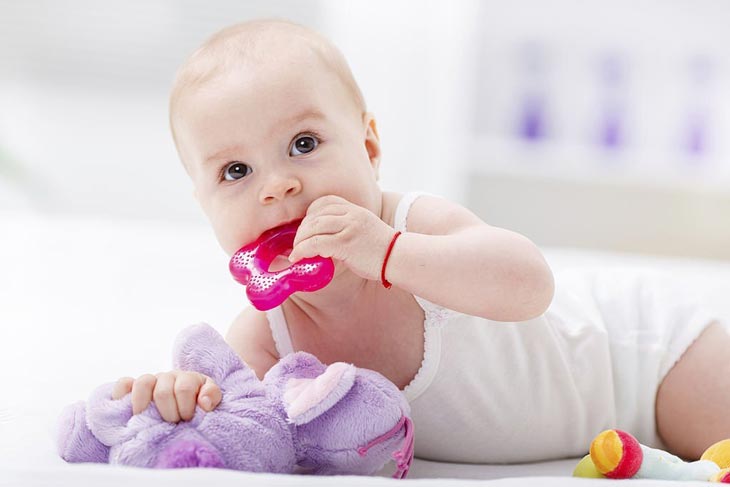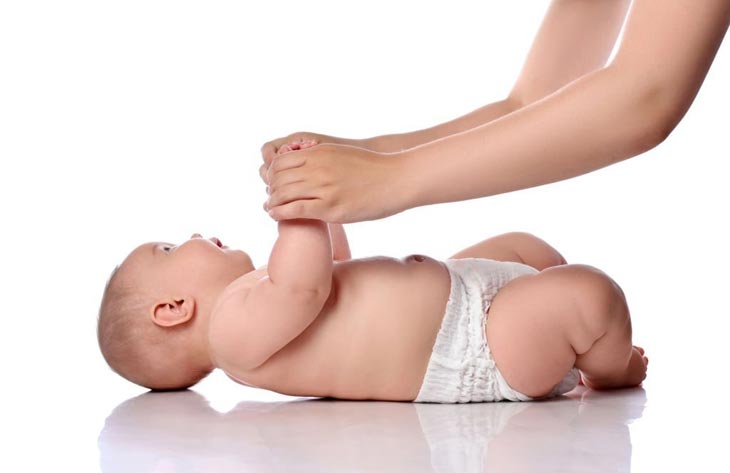If you are worried about your baby tilting head to one side teething, don’t panic, as this phenomenon may be đeeme as a common condition. What is it? The answer will be revealed in this writing.
Besides understanding the causes of a newborn’s tilted head, you will also explore a list of helpful solutions and caring tips below.
Why Is My Baby Tilting Head To One Side Teething?

Commonly, when your baby tilts their head to one side during teething, they are diagnosed to be involved in the condition of torticollis.
In other rare cases, this phenomenon is caused by eye misalignment, hearing loss, reflux, a brain tumor, lymph nodes, or throat infection.
Congenital Muscular Torticollis
Why does my baby keep leaning his head to one side? The possible reason is due to torticollis. Torticollis or wryneck relates to the neck muscles, which let the baby’s head tilt to one side.
It happens when your baby has a minor tangled fibers knot in one side of their neck. This position is scientifically called sternocleidomastoid muscle (SCM).
The tangled knot indicates that the sternocleidomastoid muscles on two sides are not even. As a result, the toddler will lean in the direction of the shorter one.
The knot can form and grow after you find yourself pregnant, when the child is still in the uterus due to an abnormal position or cramped. Their head has to bear more pressure leading to a tighter SCM.
Congenital Muscular Torticollis is always noticed by the health visitor, a pediatrician, or even the parents during the first few weeks of the newborn.
Acquired Torticollis
After birth, if your baby’s torticollis develops, it is called Acquired Torticollis. This development is rooted in a tricky birth, especially the hard first-time deliveries or breech.
Another cause of this shortening is the way your baby lies.
However, Acquired Torticollis leading to a toddler tilting head to one side teething does not have apparent symptoms until they have more neck and head control.
Klippel-Feil Syndrome
What does head slightly tilted to one side indicate? The answer would be Klippel-Feil Syndrome. This condition has appeared since the child’s birth.
When there is a fusion made up of at least two cervical vertebrae of your neck, it causes Klippel-Feil syndrome.
Being involved in this condition, the baby will have a broad, short neck with limited movement and a low hairline.
Klippel-Feil is reported to be a disorder that happens to global newborns in the ratio of 1:40,000 or 1:42,000, according to MedlinePlus.
Symptoms Of Infant Torticollis
When a toddler is diagnosed to have torticollis, this condition would have appeared since their birth.
The exact reason was the unusual position of your baby when they were in your uterus during pregnancy.
However, there are still some circumstances when torticollis exists after birth (Acquired Torticollis as mentioned above).
Thus, it is crucial to understand the symptoms of this condition and categorize them to come up with relevant solutions.
Here are the popular symptoms of torticollis for your to consider:
- One eye seems bigger compared to the other.
- The jaw is tilted.
- The back of the head side is flattened.
- One side of the cheek and forehead is bulging.
- The ear on the flattened side is pushed forward.
Solutions For Baby Tilting Head To One Side Teething
There are simple strategies to deal with the one side tilting head, such as placing your child on the back with their head oriented opposite to the tilting direction.
However, that’s not enough, as there are different solutions for each category of head tilt.
Torticollis Treatment
In fact, this condition does not hurt your child; however, it still causes trouble when the baby moves their neck. They also need proper treatment early as the long-term result is more serious.
Parents can apply the solution for both acquired and congenital types of torticollis. Particularly, there is a range of simple stretching exercises to deal with the cramped and short neck muscles.
You can search for the keyword “Exercises to improve torticollis” on Youtube and follow the instructions at home.
However, the parents may find it distressing to see their toddler follow the steps of these exercises. In this case, they can ask for support from an osteopath, a pediatric physiotherapist, or a chiropractor.
Normally, you will find apparent improvement after six months of exercising.
If you are looking for faster recovery, the condition must be diagnosed early, and your toddler has to be adherent to the treatment routine.
Klippel-Feil Syndrome Treatment
Based on the advice from a specialist, the treatment for Klippel-Feil syndrome is diversified.
Either physiotherapy or an operation would handle your baby’s condition. The same point of these methods is to eliminate the craniocervical and cervical instability.
At the same time, their spinal cord will no longer be constricted. All the methods require a hospital setting, and stretching is not recommended for this condition.
How Can You Care For Your Child With Torticollis At Home?
1. Let your baby lie on their back on an even and clean surface such as a carpeted floor or a changing table.
2. Position their head on the opposite side to the tilting side. Particularly, gently lean the opposite-sided ear toward the shoulder of the same side while letting the chin pointing toward the tilted side.
For instance, if your baby has a tilted head to the left, you should lean their right ear toward the shoulder on the right. Then, let the chin orient to the shoulder on the left.
3. Make any necessary adjustments to ensure the chin is toward the right shoulder. The same goes for holding your toddler when you feed him.
4. Place colorful objects and toys around the baby to encourage their neck movements.
5. If the treatment is stretching exercises, apply it every day. You can also consider tummy time. Remember not to leave your child alone during this process.
6. It is advised to keep your newborn lying in a crib with a big crib blanket or on the changing table. Thus, the newborn can get accurate chin movements and see the surrounding stuff easily.
FAQs
How Do I Know If My Baby Has An Ear Infection Or Teething?
There are different symptoms to tell these two conditions apart. When it comes to an ear infection, your baby’s body temperature will rise to 104°F or 40°C.
Meanwhile, if he/she has a teething problem, the body temperature would be 4.4°F or 2 °C lower.
Moreover, if your toddler has an ear infection, they will also have a cold. There would be discharges from their ear, leading to an imbalance.
Is ear pulling a sign of teething? Although numerous babies pull their ears during teething, there is no official declaration about the link between teething and ear pulling.
How Long Does Torticollis Last?
Torticollis often develops for one or a couple of days. However, its symptoms would not disappear completely until a week passed. In some cases, they may exist longer and even return unreasonably.
Conclusion

You have absorbed comprehensive information about baby tilting head to one side teething. Tilted heads in newborns are not a rare issue, but applying the relevant treatment on time is necessary.
Or else, it would result in more serious problems like one side flattened head, uneven face, limited head movements, and even permanent facial deformity.
